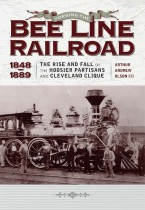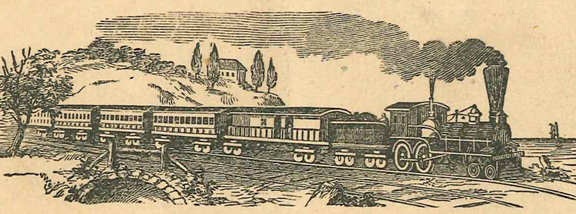
On May 11, 1848, as the Midwest railroad era dawned, Connersville-based former Indiana Congressman and Senator Oliver H. Smith took to the podium in Indianapolis: “The time has now come when central Indiana has to decide whether the immense travel, emigration, and business of the west should pass round or go through central Indiana…and not force them round by either Cincinnati on the east, or Chicago on the north.”
Smith, who had also sponsored a bill to extend the National Road through Indiana during his Congressional term in 1828, foresaw the potential economic synergies in linking Midwest railroads from the heartland with East Coast markets. Now, its citizens would need to make the financial investment to make it happen. And the mechanism to ignite this explosive rush was not a rutted path or canal, but a new form of transportation in the Midwest: a railroad. It would be among Indiana’s first.
By July, Smith had tallied the necessary stock purchase commitments or “subscriptions” to incorporate the railroad destined to link Indianapolis to Cleveland on one end, and to St. Louis on the other. In legal terms, it was called The Indianapolis and Bellefontaine Railroad [I&B], extending 83 miles northeast from Indianapolis to an undefined location in the wilderness along the Ohio state line.
Soon, it connected with two others Ohio railroads to reach Cleveland – one with a confusingly similar name: The Bellefontaine and Indiana Railroad [B&I]. The other was already the regional powerhouse that soon financed, controlled and finally swallowed the other two: The Cleveland, Columbus and Cincinnati Railroad [CC&C]. But to the traveling public the complete or partial string of railroads linking these economic centers became known as the Bee Line – like a bumblebee’s nearly straight-line path between these two cities.
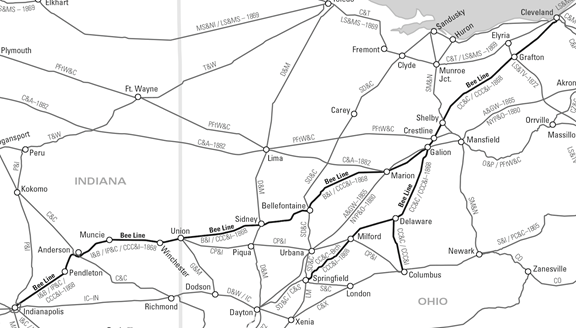
The pedigree of Smith’s first board of directors read like a Who’s Who of eastern Indiana politicians and business leaders. Because the bulk of initial stock subscriptions came from county boards through which the line would pass, representatives from Marion, Hancock, Madison, Delaware and Randolph counties populated the first board. Many were closely affiliated with Oliver Smith in terms of shared political and legal careers – such as Jeremiah Smith of Randolph County and David Kilgore of Delaware County.
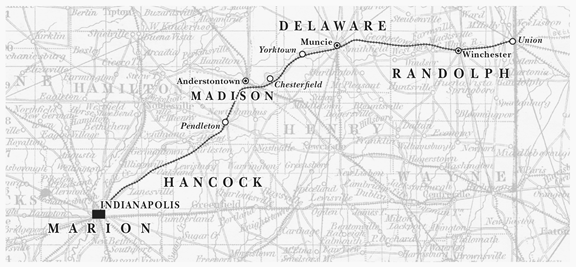
The two Smiths had met in the mid 1820s when both served as state and county prosecuting attorneys. Oliver appointed Jeremiah to chair the Indianapolis and Bellefontaine’s committee to locate its eastern terminus somewhere along the Ohio state line. Once determined, the Smiths moved quickly to capitalize on their insider information. They purchased the land and platted what shortly became known as Union – today’s Union City. Jeremiah in particular would profit handsomely, as Union became a key Midwest railroad junction town by the mid 1850s.
And because early railroad companies did not allow locomotives or rail cars to travel beyond their geographic/corporate boundaries, Union bustled with activity. Oliver Smith rationalized that the avoidance of potential accidents and repairs to cars sent out of state “would more than counter balance any inconvenience growing out of transfers at the State Line, from one line to another.” One can only guess the passengers’ reaction to this rationale, as they were often forced to stay overnight at Union’s Branham House hotel awaiting an onward train.
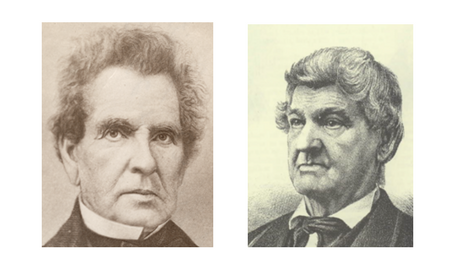
David Kilgore, on the other hand, had been active with Oliver Smith in Indiana Whig politics. They often served as lawyers on the same case, and grew close as Smith purchased the land and platted Kilgore’s Yorktown hometown in 1837. Kilgore owned a parcel adjacent to Yorktown as well as a sizeable farm on the Indianapolis Road between Yorktown and Daleville. Conveniently, the Bee Line would slice through both parcels of Kilgore’s land – not to mention curving through Smith’s Yorktown.
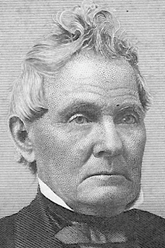
As prominent editor Henry V. Poor of the nationally renowned American Railroad Journal spouted about the route of the Bee Line: “the road undoubtedly should have been constructed on a direct line between Indianapolis and Union…why did he not take this line for the Bellefontaine road? Because he owned some property at Yorktown or Muncietown and curved the road to promote his private interests.” Railroading was about more than just railroading.
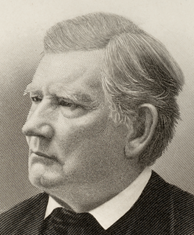
The opportunities for personal gain abounded in building the railroad as well. Nearly all of the directors gained lucrative contracts to supply ties for long stretches of the route, for building depots, and representing the Bee Line in right-of-way disputes. Then, as funding grew thin, Indianapolis entrepreneur Daniel Yandes and banker Alfred Harrison teamed up to finance and complete construction of the route from Chesterfield to Union – essentially taking stock and board control of Smith’s railroad even before the first train reached Union in 1853.
Oliver Smith’s eagerness to cut lucrative side business deals connected to the Bee Line ultimately proved to be his undoing. In 1853, Indianapolis led the country by constructing the nation’s first “Union Station“. Remarkably, until then, different railroads terminating in the same metropolitan center did not share a common station or depot. They would often be miles apart from each other. While good for local transportation companies, warehouses and hotels, it made little long-term business sense. Although the Indianapolis and Bellefontaine’s depot in the northeast corner of Indianapolis was the outlier among all others, Smith refused to place a machine or repair shop facility closer to Union Station.
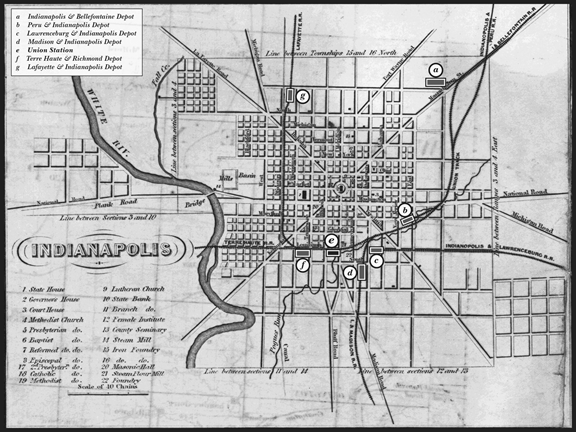
Calvin Fletcher, the highly-regarded Indianapolis civic leader and banker through whose land the Bee Line passed – and who assumed a board position in mid 1852 – took note of Smith’s rationale for resistance. Recounting the board issue in his diary, Fletcher observed: “The subject of removal of the Depo [sic] now built on the North East part of the town would be adjitated [sic]. This I knew would be extremely offensive to Mr. O.H. Smith…as he was, as I supposed, connected with Billy Young in the property in its vicinity.”
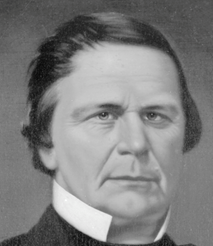
Smith was still laboring under the misimpression that his authority was all but absolute. He had clearly dismissed the board power shift that occurred the year before when Daniel Yandes and Alfred Harrison struck a stock payout deal to complete building the road to Union. The emerging Hoosier Partisans power group which grew to include Calvin Fletcher – whose board election they orchestrated – and David Kilgore, however, relegated Smith to the sidelines. By the Spring of 1853 they accepted his resignation from the board of the railroad he had toiled to bring to life.
As was typical of early Midwest railroad boards, the Bee Line far underestimated the amount of capital required to bring such a massive undertaking to life. For early Midwest businessmen, financing and operating such large corporate organizations were matters of first impression. And with hard cash virtually non-existent, individuals could commit to purchase stock by pledging labor, materials or land. Such arrangements often left the railroad cash poor and unable to meet its obligations. County governments, with pushback from both its citizens and Indiana’s governor, had reached their limit as well.
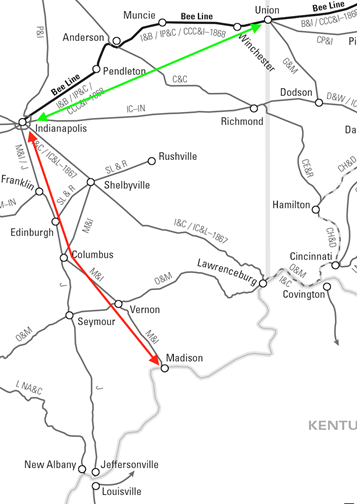
Fortunately for the Indianapolis and Bellefontaine and Indiana’s first railroad, the Madison and Indianapolis Railroad [M&I] (completed in 1847), their pressing mutual financial problems would be the solution for each. The M&I had a supply of unused rails, underutilized equipment, and a solid credit position – courtesy of its earlier birth as a state-run and funded railroad. But it was slowly diminishing in importance as its route to Indiana’s Ohio River port city of Madison could not rival the well establish and larger commercial cities just up and down river – Cincinnati and Louisville. And the situation became more acute when Indiana’s legislature allowed any group of individuals able to raise $50,000 to build a railroad to anywhere in the state without a special charter. Those headed toward Cincinnati and Louisville were at the top of the list.
On the other hand, the I&B possessed an enviable route pointed toward Cleveland and ultimately the East Coast. However, it needed the credit to which the M&I had access – not to mention rails to finish its construction, and equipment and operating personnel to actually run the line. It appeared to be a ‘win-win’ for both. M&I’s President, John Brough, saw this opportunity and capitalized on the situation.
By the time the Bee Line’s first segment, the I&B, opened between Indianapolis and Pendleton in 1851, Brough’s M&I would be supplying rolling stock and operating personnel as well as financial backing. It would not come without a cost. The balance of his life and career would be closely tied to the Bee Line. However, this new relationship also signaled the beginning of a love-hate affair between Brough and the Hoosier Partisans.
Check back for Part II to learn more about John Brough’s career and relationship with the Bee Line, and the financier behind the growth of Midwest railroads: Indiana’s James F. D. Lanier.
Interested in the Bee Line?
Click on the Bee Line book Cover to LEARN MORE

